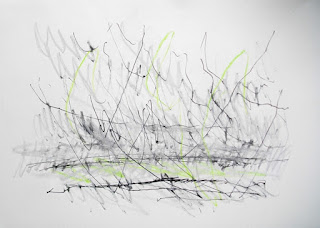HILDA DEVOS, 29 x oil on canvas.
The results of my drawing expeditions, mostly along the banks of the Schelde. I draw in open air as often as I can. Usually my drawings end up in storage in my studio. Recently, I realized that I can 'store' my drawings in this blog, on view for anyone interested in drawing (and painting).
Sunday, 13 September 2020
Just when you thought painting was dead (again)...
Wednesday, 12 August 2020
A little hardn'd
Unable - or unwilling - to cross the border, am left to ponder the strange times. For some cheer, reading Defoe's A Journal of the Plague Year. About he early stages of the 'Distemper', he writes:
"But the Fright was not yet near so great in the City, abstractly so called; and particularly because, tho' they were at first in the most inexpressible Consternation, yet as I have observ'd, that the Distemper intermitted often at first; so they were as it were, allarm'd, and unallarmed again, and this several times, till it began to be familiar to them; and that even, when it appear'd violent, yet seeing it did not presently spread into the City, or the East and South Parts, the People began to take Courage, and to be, as I may say, a little hardn'd."
Daniel Defoe, A Journal of the Plague Year, Penguin Classics
Strangely - considering Defoe's accurate psychological insight - the author was 5 years old when the Great Plague broke out, in 1665. His 'account' wasn't published until 1722, 57 years later.
Thursday, 16 July 2020
Drizzle
Drizzle with intermittent showers. Fresh (13-14°C). Rather a breeze, from WSW to W, compelling me - as I'm facing south - to have my umbrella on my right side. Therefore, could not see where the weather was coming from, or rather, what weather was coming. Facing S-SE, more or less towards Doel.
Beautiful rapidly changing light and texture effects, fortunately too fleeting to tempt me to 'capture'.
Yet I'm surprised that I have to acclimatize to the lack of 'picturesque' of this land. Probably for the best. Not to fall asleep.
Hare, black-headed gulls, swifts (swallows?). Lambs silently grazing on the dike. Very little tidal movement. Faraway thumping and rumbling of container-ships, rhythmic swish of the two windmills to the east, sizzle of the drizzle on my umbrella.
Thursday, 18 June 2020
The Third Eye
Thursday, 23 April 2020
Waiting for Godot in Times of Corona
A couple of doors down our street, some weeks ago, a family hung out a piece of white cloth, as have so many.
The difference is, on their sheet they have written:
The lettering is in black, except for the word "GOD", which was in an orange-brown. Now, after a few rain showers, the apparently water-soluble orange-brown ink has completely washed away, leaving the exhortation:
And thus, in a move towards secularization, Religion develops into pure Philosophy.
It is as if an absent God has sent a sign: "Hold on you people, I am NOT involved in this! I am not even here (there)!"
The effect would possibly have been all the more ominous, had the main text been in orange-brown with the word "GOD" in black...
(Praise Thee for resisting the urge to make thàt joke.)
Let us all keep on searching. Amen.
Thursday, 27 February 2020
Sapere aude!
Monday, 13 January 2020
Museum 2.0: The Greatest Show on Earth
 |
| Vincent van Rijn, raising an eyebrow at his visitors. |
Also, many enjoy the pleasure of taking selfies, while posing in front of a Vermeer, a Velasquez, or a Ruysdael. Whole families, at times.
The lighting: as is their wont, the curators in their wisdom have chosen for artificial ambiant lighting, very much toned down. In the Van Gogh Museum, every pane of glass is blacked out with acres of black gauze. It is, as a matter of fact, just as dark and dusky as a 19th century bourgeois salon - quite in keeping with the (post-)impressionist Zeitgeist and esthetics. The paintings themselves, on the contrary, are cunningly lit up by means of batteries of floodlights. A happy example of this is the famous Neighbourhood Watch, bij Vincent van Rijn, in the Rijksmuseum. van Rijn, not having fully mastered the art of chiaroscuro, is taught a valuable lesson by the curator (scenographer? see infra), who has decided to aim an armful of floodlights at the critical (lighted) areas of the Watch, thereby making it into a true Masterpiece.
Generally speaking the spotlights cast informative shadows of the upper part of the picture frame onto the paintings, or reflect in the lower profile of the frame. This, in order to direct the viewer's attention to the often sumptuous frames.












































